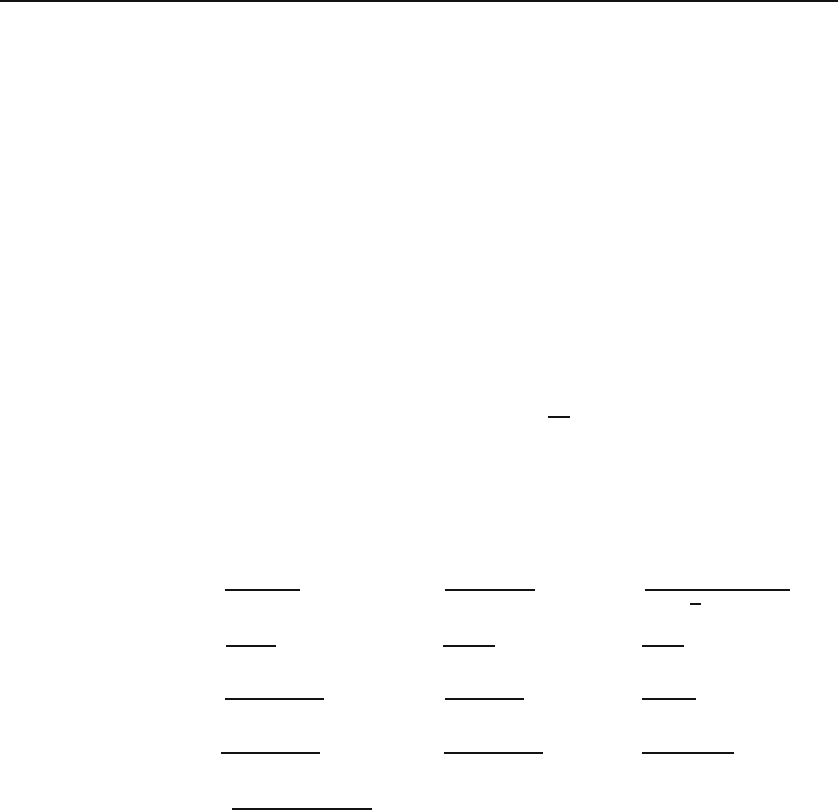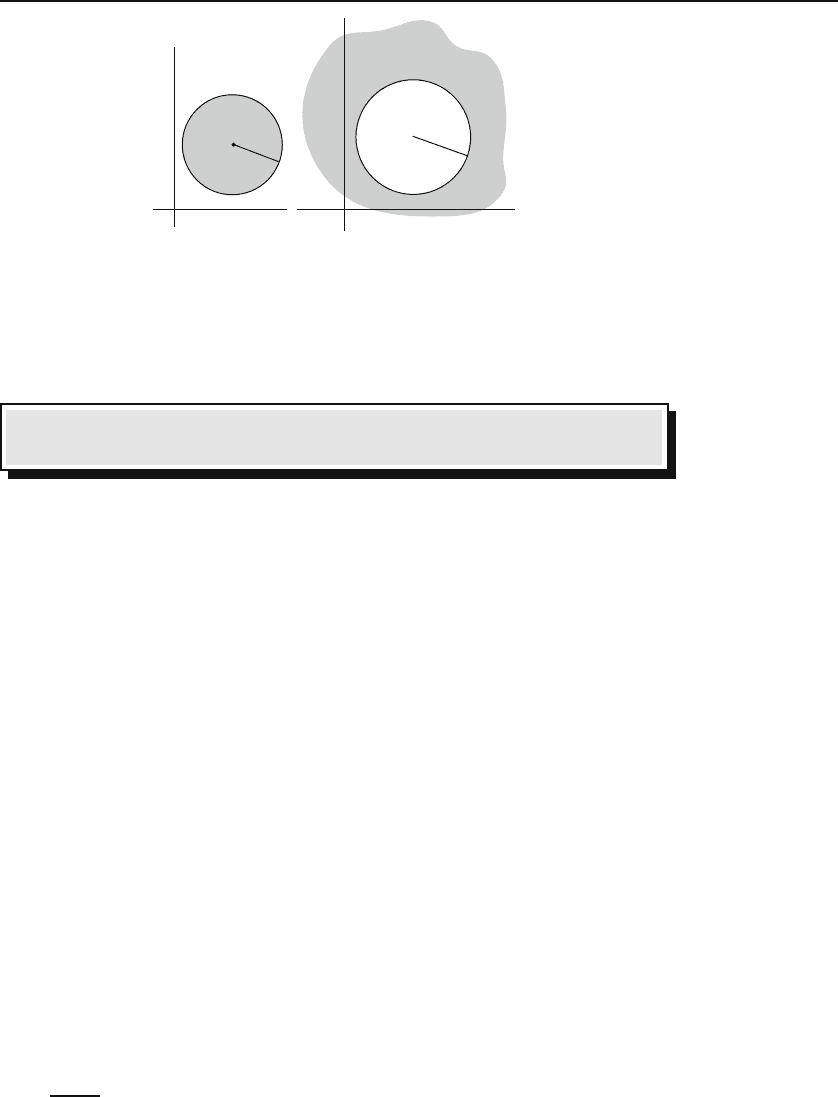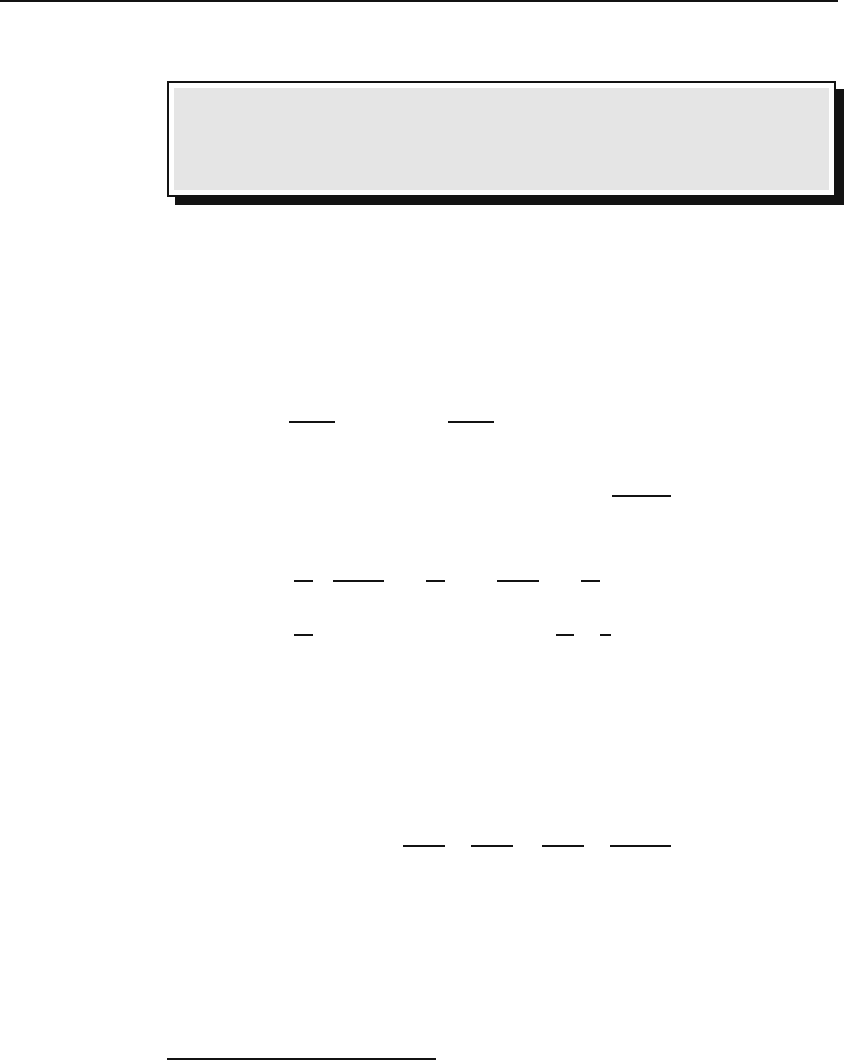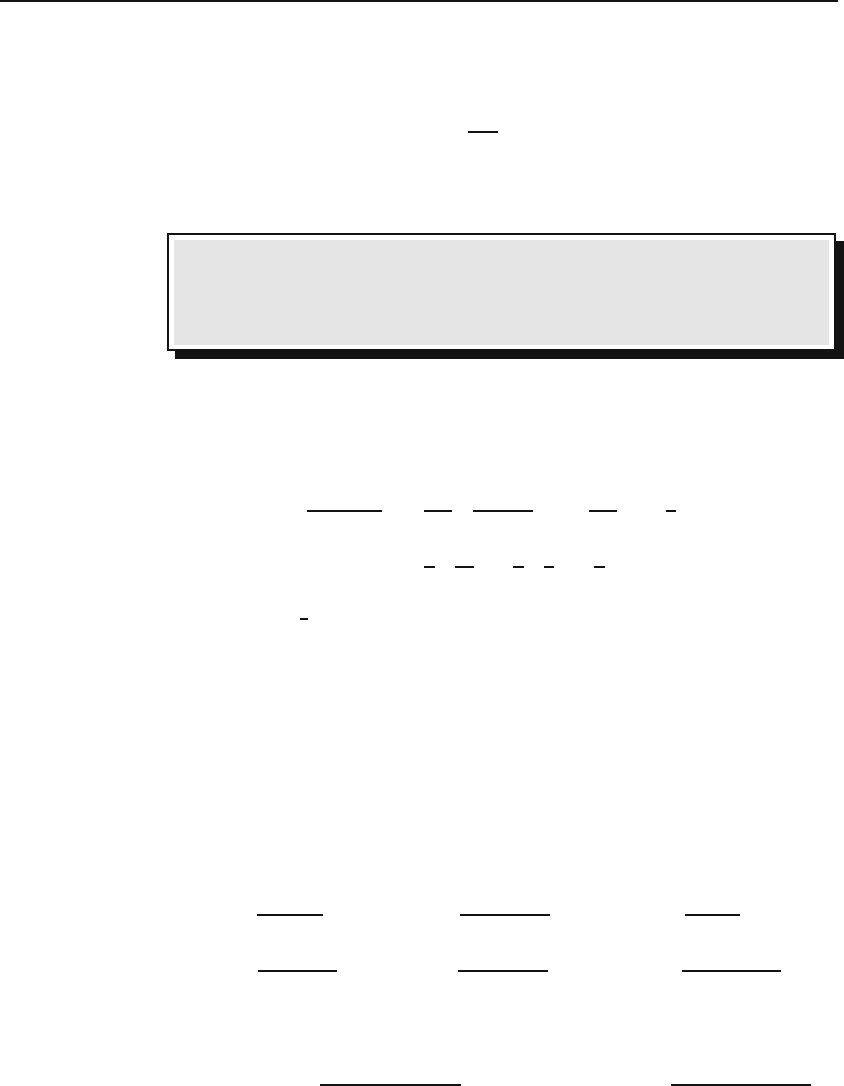Hassani S. Mathematical Methods: For Students of Physics and Related Fields
Подождите немного. Документ загружается.


19.2 Problems 513
19.12. Verify the following hyperbolic identities:
(a) cosh
2
z − sinh
2
z =1.
(b) cosh(z
1
+ z
2
)=coshz
1
cosh z
2
+sinhz
1
sinh z
2
.
(c) sinh(z
1
+ z
2
)=sinz
1
cosh z
2
+coshz
1
sinh z
2
.
(d) cosh 2z =cosh
2
z +sinh
2
z, sinh 2z =2sinhz cosh z.
(e) tanh(z
1
+ z
2
)=
tanh z
1
+tanhz
2
1+tanhz
1
tanh z
2
.
19.13. Show that
(a)tanh
z
2
=
sinh x + i sin y
cosh x +cosy
. (b) coth
z
2
=
sinh x −i sin y
cosh x − cos y
.
19.14. Prove the following identities:
(a) cos
−1
z = −i ln(z ±
z
2
− 1). (b) sin
−1
z = −i ln[iz ±
1 − z
2
)].
(c) tan
−1
z =
1
2i
ln
i − z
i + z
. (d) cosh
−1
z =ln(z ±
z
2
− 1).
(e) sinh
−1
z =ln(z ±
z
2
+1). (f) tanh
−1
z =
1
2
ln
1+z
1 − z
.
19.15. Prove that exp(z
∗
) is not analytic anywhere.
19.16. Show that e
iz
=cosz + i sin z for any z.
19.17. Show that both the real and imaginary parts of an analytic function
are harmonic.
19.18. Show that each of the following functions—call each one u(x, y)—
is harmonic, and find the function’s harmonic partner, v(x, y), such that
u(x, y)+iv(x, y) is analytic. Hint: Use C–R conditions.
(a) x
3
− 3xy
2
. (b) e
x
cos y. (c)
x
x
2
+ y
2
where x
2
+ y
2
=0.
(d) e
−2y
cos 2x. (e) e
y
2
−x
2
cos 2xy.
(f) e
x
(x cos y − y sin y)+2sinhy sin x + x
3
− 3xy
2
+ y.
19.19. Describe the curve defined by each of the following equations:
(a) z =1− it, 0 ≤ t ≤ 2. (b) z = t + it
2
, −∞ <t<∞.
(c) z = a(cos t + i sin t)
π
2
≤ t ≤
3π
2
. (d) z = t +
i
t
−∞<t<0.
19.20. Let f(z)=w = u + iv. Suppose that
∂
2
Φ
∂x
2
+
∂
2
Φ
∂y
2
= 0. Show that if f
is analytic, then
∂
2
Φ
∂u
2
+
∂
2
Φ
∂v
2
= 0. That is, analytic functions map harmonic
functions in the z-plane to harmonic functions in the w-plane.

514 Complex Derivative and Integral
19.21. (a) Show that
f(z) dz can be written as
#
A · dr + i
#
B · dr,
where A = u, −v, 0, B = v, u, 0,anddr = dx, dy, 0.
(b) Show that both A and B have vanishing curls when f is analytic.
(c) Now use the Stokes’ theorem to prove the Cauchy–Goursat theorem.
19.22. Find the value of the integral
C
[(z +2)/z] dz,whereC is: (a) the
semicircle z =2e
iθ
,for0≤ θ ≤ π; (b) the semicircle z =2e
iθ
,forπ ≤ θ ≤ 2π;
and (c) the circle z =2e
iθ
,for−π ≤ θ ≤ π.
19.23. Evaluate the integral
γ
dz/(z −1 −i)whereγ is: (a) the line joining
z
1
=2i and z
2
= 3; and (b) the path from z
1
to the origin and from there to
z
2
.
19.24. Use Equation (19.10) to show that
d
dz
(z
m
)=mz
m−1
.Hint:Usethe
binomial theorem.
19.25. Let C be the boundary of a square whose sides lie along the lines
x = ±3andy = ±3. For the positive sense of integration, evaluate each of
the following integrals by using CIF or the derivative formula (19.10):
(a)
2
C
e
−z
z − iπ/2
dz. (b)
2
C
e
z
z(z
2
+ 10)
dz. (c)
2
C
cos z
(z −
π
4
)(z
2
− 10)
dz.
(d)
2
C
sinh z
z
4
dz. (e)
2
C
cosh z
z
4
dz. (f)
2
C
cos z
z
3
dz.
(g)
2
C
cos z
(z − iπ/2)
2
dz. (h)
2
C
e
z
(z − iπ)
2
dz. (i)
2
C
cos z
z + iπ
dz.
(j)
2
C
e
z
z
2
− 5z +4
dz. (k)
2
C
sinh z
(z − iπ/2)
2
dz. (l)
2
C
cosh z
(z − π/2)
2
dz.
(m)
2
C
z
2
(z − 2)(z
2
− 10)
dz.

Chapter 20
Complex Series
As in the real case, representation of functions by infinite series of “simpler”
functions is an endeavor worthy of our serious consideration. We start with
an examination of the properties of sequences and series of complex numbers
and derive series representations of some complex functions. Most of the
discussion is a direct generalization of the results of the real series.
A sequence {z
k
}
∞
k=1
of complex numbers is said to converge to a limit z if sequence,
convergence to a
limit, partial sums,
and series
lim
k→∞
|z − z
k
| = 0. In other words, for each positive number ε there must
exist an integer N such that |z − z
k
| <εwhenever k>N.Thereadermay
show that the real (imaginary) part of the limit of a sequence of complex
numbers is the limit of the real (imaginary) part of the sequence. Series can
be converted into sequences by partial summation. For instance, to study
the infinite series
∞
k=1
z
k
, we form the partial sums Z
n
≡
n
k=1
z
k
and
investigate the sequence {Z
n
}
∞
n=1
. We thus say that the infinite series
∞
k=1
z
k
converges to Z if lim
n→∞
Z
n
= Z.
Example 20.0.1.
A series that is used often in analysis is the geometric series
Z =
∞
k=0
z
k
. Let us show that this series converges to 1/(1 −z)for|z| < 1. For a
partial sum of n terms, we have
Z
n
≡
n
k=0
z
k
=1+z + z
2
+ ···+ z
n
.
Multiply this by z and subtract the result from the Z
n
sum to get (see also Example
9.3.3)
Z
n
− zZ
n
=1− z
n+1
⇒ Z
n
=
1 − z
n+1
1 − z
.
We now show that Z
n
converges to Z =1/(1 − z). We have
|Z − Z
n
| =
1
1 − z
−
1 − z
n+1
1 − z
=
z
n+1
1 − z
=
|z|
n+1
|1 − z|
and
lim
n→∞
|Z − Z
n
| = lim
n→∞
|z|
n+1
|1 − z|
=
1
|1 − z|
lim
n→∞
|z|
n+1
=0
for |z| < 1. Thus,
∞
k=0
z
k
=1/(1 − z)for|z| < 1.

516 Complex Series
If the series
∞
k=0
z
k
converges, both the real part,
∞
k=0
x
k
,andthe
imaginary part,
∞
k=0
y
k
, of the series also converge. From Chapter 9, we
know that a necessary condition for the convergence of the real series
∞
k=0
x
k
and
∞
k=0
y
k
is that x
k
→ 0andy
k
→ 0. Thus, a necessary condition for
the convergence of the complex series is lim
k→∞
z
k
= 0. The terms of such a
series are, therefore, bounded. Thus, there exists a positive number M such
that |z
k
| <M for all k.
A complex series is said to converge absolutely,ifthereal series
absolute
convergence
∞
k=0
|z
k
| =
∞
k=0
x
2
k
+ y
2
k
converges. Clearly, absolute convergence implies convergence.
20.1 Power Series
We now concentrate on the power series which, as in the real case, are infinite
sums of powers of (z − z
0
). It turns out—as we shall see shortly—that for
complex functions, the inclusion of negative powers is crucial.
power series
Theorem 20.1.1. If the power series
∞
k=0
a
k
(z − z
0
)
k
converges for z
1
(assumed to be different from z
0
), then it converges absolutely for every value
of z such that |z −z
0
| < |z
1
−z
0
|. Similarly if the power series
∞
k=0
b
k
/(z −
z
0
)
k
converges for z
2
= z
0
, then it converges absolutely for every value of z
such that |z −z
0
| > |z
2
− z
0
|.
Proof. We prove the first part of the proposition; the second part is done
similarly. Since the series converges for z = z
1
,alltheterms|a
k
(z
1
− z
0
)
k
|
are smaller than a positive number M. We, therefore have
∞
k=0
|a
k
(z − z
0
)
k
| =
∞
k=0
a
k
(z
1
− z
0
)
k
(z − z
0
)
k
(z
1
− z
0
)
k
=
∞
k=0
|a
k
(z
1
− z
0
)
k
|
z − z
0
z
1
− z
0
k
≤
∞
k=0
MB
k
= M
∞
k=0
B
k
=
M
1 − B
,
where B ≡|(z − z
0
)/(z
1
− z
0
)| is a positive real number less than 1. Since
the RHS is a finite (positive) number, the series of absolute values converges,
and the proof is complete.
The essence of Theorem 20.1.1 is that if a power series—with positive
powers—converges for a point at a distance r
1
from z
0
,thenitconvergesfor
all interior points of a circle of radius r
1
centered at z
0
. Similarly, if a power
series—with negative powers—converges for a point at a distance r
2
from z
0
,
then it converges for all exterior points of a circle of radius r
2
centered at z
0
(see Figure 20.1).

20.1 Power Series 517
z
0
r
1
(a)
(b)
z
0
r
2
Figure 20.1: (a) Power series with positive exponents converge for the interior points
of a circle. (b) Power series with negative exponents converge for the exterior points of
a circle.
Box 20.1.1. When constructing power series, positive powers are used
for points inside a circle and negative powers for points outside it.
The largest circle about z
0
such that the first power series of Theorem
20.1.1 converges is called the circle of convergence of the power series. It
circle of
convergence
follows from Theorem 20.1.1 that the series cannot converge at any point
outside the circle of convergence. (Why?)
Let us consider the power series
S(z) ≡
∞
k=0
a
k
(z − z
0
)
k
(20.1)
which we assume to be convergent at all points interior to a circle for which
|z − z
0
| = r. This implies that the sequence of partial sums {S
n
(z)}
∞
n=0
converges. Therefore, for any ε>0, there exists an integer N
ε
such that
|S(z) − S
n
(z)| <ε whenever n>N
ε
.
In general, the integer N
ε
may be dependent on z; that is, for different values uniform
convergence
explained
of z, we may be forced to pick different N
ε
’s. When N
ε
is independent of z,we
say that the convergence is uniform. We state the following result without
proof:
a power series is
uniformly
convergent and
analytic; it can be
differentiated and
integrated term by
term.
Theorem 20.1.2. The power series S(z)=
∞
n=0
a
n
(z −z
0
)
n
is uniformly
convergent for all points within its circle of convergence, and S(z) is an ana-
lytic function of z there. Furthermore, such a series can be differentiated and
integrated term by term:
dS(z)
dz
=
∞
n=1
na
n
(z − z
0
)
n−1
,
#
γ
S(z) dz =
∞
n=0
a
n
#
γ
(z − z
0
)
n
dz,

518 Complex Series
at each point z and each path γ located inside the circle of convergence of the
power series.
By substituting the reciprocal of (z −z
0
) in the power series, we can show
that if
∞
k=0
b
k
/(z −z
0
)
k
is convergent in the annulus r
2
< |z −z
0
| <r
1
,then
it is uniformly convergent for all z in that annulus, and the series represents
a continuous function of z there.
20.2 Taylor and Laurent Series
Complex series, just as their real counterparts, find their most frequent utility
in representing well-behaved functions. The following theorem, which we state
without proof,
1
is essential in the application of complex analysis.
Theorem 20.2.1. Let C
1
and C
2
be circles of radii r
1
and r
2
,bothcentered
at z
0
in the z-plane with r
1
>r
2
.Letf(z) be analytic on C
1
and C
2
and
throughout S, the annular region between the two circles. Then, at each point
z of S, f(z) is given uniquely by the Laurent series
f(z)=
∞
n=−∞
a
n
(z − z
0
)
n
, where a
n
=
1
2πi
2
C
f(ξ)
(ξ − z
0
)
n+1
dξ,
and C is any contour within S that encircles z
0
.Whenr
2
=0,theseriesis
called Taylor series. In that case a
n
=0for negative n and a
n
= f
(n)
(z
0
)/n!
for n ≥ 0.
We can see the reduction of the Laurent series to Taylor series as follows.
The Laurent expansion is convergent as long as r
2
< |z − z
0
| <r
1
.Inpartic-
ular, if r
2
= 0, and if the function is analytic throughout the interior of the
larger circle, then f (ξ)/(ξ −z
0
)
n+1
will be analytic for negative integer n,and
the integral will be zero by the Cauchy–Goursat theorem. Therefore, a
n
will
be zero for n = −1, −2,.... Thus, only positive powers of (z − z
0
) will be
present in the series, and we obtain the Taylor series.
For z
0
= 0, the Taylor series reduces to the Maclaurin series:Maclaurin series
f(z)=f(0) + f
(0)z + ···=
∞
n=0
f
(n)
(0)
n!
z
n
.
Box 19.1.4 tells us that we can enlarge C
1
and shrink C
2
until we encounter
a point at which f is no longer analytic. Thus, we can include all the possible
analytic points by enlarging C
1
and shrinking C
2
.
Example 20.2.2.
Let us expand some functions in terms of series. For entire
functions there is no point in the entire complex plane at which they are not analytic.
1
For a proof, see Hassani, S. Mathematical Physics: A Modern Introduction to Its Foun-
dations, Springer-Verlag, 1999, Section 9.6.

20.2 Taylor and Laurent Series 519
Thus, only positive powers of (z − z
0
) will be present, and we will have a Taylor
expansion that is valid for all values of z.
(a) We expand e
z
around z
0
=0. Thenth derivative of e
z
is e
z
.Thus,f
(n)
(0) = 1,
and the Taylor (Maclaurin) expansion gives
e
z
=
∞
n=0
f
(n)
(0)
n!
z
n
=
∞
n=0
z
n
n!
.
(b) The Maclaurin series for sin z is obtained by noting that
d
n
dz
n
sin z
z=0
=
0
0ifn is even,
(−1)
(n−1)/2
if n is odd,
and substituting this in the Maclaurin expansion:
sin z =
n odd
(−1)
(n−1)/2
z
n
n!
=
∞
k=0
(−1)
k
z
2k+1
(2k +1)!
.
Similarly, we can obtain
cos z =
∞
k=0
(−1)
k
z
2k
(2k)!
, sinh z =
∞
k=0
z
2k+1
(2k +1)!
, cosh z =
∞
k=0
z
2k
(2k)!
.
It is seen that the series representation of all these functions is obtained by replacing
the real variable x in their real series representation with a complex variable z.
(c) The function 1/(1+z) is not entire, so the region of its convergence is limited. Let
us find the Maclaurin expansion of this function. Starting from the origin (z
0
=0),
the function is analytic within all circles of radii r<1. At r =1weencountera
singularity, the point z = −1. Thus, the series converges for all points z for which
|z| < 1.
2
For such points we have
f
(n)
(0) =
d
n
dz
n
[(1 + z)
−1
]
z=0
=(−1)
n
n!.
Thus,
1
1+z
=
∞
n=0
f
(n)
(0)
n!
z
n
=
∞
n=0
(−1)
n
z
n
.
The Taylor and Laurent series allow us to express an analytic function as
a power series. For a Taylor series of f(z) the expansion is routine because
the coefficient of its nth term is simply f
(n)
(z
0
)/n!, where z
0
is the center of
the circle of convergence. However, when a Laurent series is applicable in a
there is only one
Laurent series for
a given function
defined in a given
region.
given region of the complex plane, the nth coefficient is not, in general, easy to
evaluate. Usually it can be found by inspection and certain manipulations of
other known series. Then the uniqueness of Laurent series expansion assures
us that the series so obtained is the unique Laurent series for the function in
that region.
3
2
As remarked before, the series diverges for all points outside the circle |z| =1. This
does not mean that the function cannot be represented by a series for points outside the
circle. On the contrary, we shall see shortly that the Laurent series, with negative powers
is designed precisely for such a purpose.
3
See Hassani, S. Mathematical Physics: A Modern Introduction to Its Foundations,
Springer-Verlag, 1999, p. 258.

520 Complex Series
As in the case of real series,we can add,
subtract, and
multiply
convergent power
series.
Box 20.2.1. We can add, subtract, and multiply convergent power series.
Furthermore, if the denominator does not vanish in a neighborhood of a
point z
0
, then we can obtain the Laurent series of the ratio of two power
series about z
0
by long division.
Thus converging power series can be manipulated as though they were
finite sums (polynomials). Such manipulations are extremely useful when
dealing with Taylor and Laurent expansions in which the straightforward cal-
culation of coefficients may be tedious. The following examples illustrate the
power of infinite-series arithmetic. In these examples, the following equations
are very useful:
1
1 − z
=
∞
n=0
z
n
,
1
1+z
=
∞
n=0
(−1)
n
z
n
, |z| < 1. (20.2)
Example 20.2.3.
To expand the function f(z)=
2+3z
z
2
+ z
3
in a Laurent series
about z =0,rewriteitas
f(z)=
1
z
2
2+3z
1+z
=
1
z
2
3 −
1
1+z
=
1
z
2
3 −
∞
n=0
(−1)
n
z
n
=
1
z
2
(3 − 1+z − z
2
+ z
3
−···)=
2
z
2
+
1
z
− 1+z − z
2
+ ··· .
This series converges for 0 < |z| < 1. We note that negative powers of z are also
present. This is a reflection of the fact that the function is not analytic inside the
entire circle |z| =1;itdivergesatz =0.
Example 20.2.4. The function f(z)=z/[(z − 1)(z −2)] has a Taylor expansion
around the origin for |z| < 1. To find this expansion, we write
4
f(z)=−
1
z − 1
+
2
z − 2
=
1
1 − z
−
1
1 − z/2
.
Expanding both fractions in geometric series (both |z| and |z/2| are less than 1), we
obtain f(z)=
∞
n=0
z
n
−
∞
n=0
(z/2)
n
. Adding the two series yields
f(z)=
∞
n=0
(1 − 2
−n
)z
n
for |z| < 1.
This is the unique Taylor expansion of f(z) within the circle |z| =1.
4
We could, of course, evaluate the derivatives of all orders of the function at z =0and
use the Maclaurin formula. However, the present method gives the same result much more
quickly.

20.2 Taylor and Laurent Series 521
For the annular region 1 < |z| < 2 we have a Laurent series. This can be seen
by noting that
f(z)=
1/z
1/z − 1
−
1
1 − z/2
= −
1
z
1
1 − 1/z
−
1
1 − z/2
.
Since both fractions on the RHS are analytic in the annular region (|1/z| < 1,
|z/2| < 1), we get
f(z)=−
1
z
∞
n=0
1
z
n
−
∞
n=0
z
2
n
= −
∞
n=0
z
−n−1
−
∞
n=0
2
−n
z
n
= −
−∞
n=−1
z
n
−
∞
n=0
2
−n
z
n
= −
∞
n=−∞
a
n
z
n
,
where a
n
= −1forn<0anda
n
= −2
−n
for n ≥ 0. This is the unique Laurent
expansion of f(z)inthegivenregion.
Finally, for |z| > 2wehaveonlynegativepowersofz. We obtain the expansion
in this region by rewriting f(z) as follows:
f(z)=−
1/z
1 − 1/z
+
2/z
1 − 2/z
.
Expanding the fractions yields
f(z)=−
∞
n=0
z
−n−1
+
∞
n=0
2
n+1
z
−n−1
=
∞
n=0
(2
n+1
− 1)z
−n−1
.
This is again the unique expansion of f (z) in the region |z| > 2.
The example above shows that a single function may have different series
representations in different regions of the complex plane, each series having
its own region of convergence.
Example 20.2.5.
Define f(z)as
f(z)=
0
(1 − cos z)/z
2
for z =0,
1
2
for z =0.
We can show that f(z) is an entire function.
Since 1 − cos z and z
2
are entire functions, their ratio is analytic everywhere
except at the zeros of its denominator. The only such zero is z =0. Thus,f(z)is
analytic everywhere except possibly at z = 0. To see the behavior of f(z)atz =0,
we look at its Maclaurin series:
1 − cos z =1−
∞
n=0
(−1)
n
z
2n
(2n)!
which implies that
1 − cos z
z
2
=
∞
n=1
(−1)
n+1
z
2n−2
(2n)!
=
1
2
−
z
2
4!
+
z
4
6!
−···.
The expansion on the RHS shows that the value of the series is
1
2
, which, by defini-
tion, is f(0). Thus, the series converges for all z, and Box 20.1.2 says that f (z)is
entire.

522 Complex Series
A Laurent series can give information about the integral of a function
around a closed contour in whose interior the function may not be analytic.
In fact, the coefficient of the first negative power in a Laurent series is given by
a
−1
=
1
2πi
2
C
f(ξ) dξ. (20.3)
Thus,
Box 20.2.2. To find the integral of a (nonanalytic) function around a
closed contour surrounding z
0
, write the Laurent series for the function
andreadoffa
−1
, the coefficient of the 1/(z − z
0
) term. The integral is
2πia
−1
.
Example 20.2.6. As an illustration of this idea, let us evaluate the integral I =
E
C
dz/[z
2
(z −2)], where C is a circle of radius 1 centered at the origin. The function
is analytic in the annular region 0 < |z| < 2. We can, therefore, expand it as a
Laurent series about z = 0 in that region:
1
z
2
(z −2)
= −
1
2z
2
1
1 − z/2
= −
1
2z
2
∞
n=0
z
2
n
= −
1
2
1
z
2
−
1
4
1
z
−
1
8
−···.
Thus, a
−1
= −
1
4
,and
E
C
dz/[z
2
(z − 2)] = 2πia
−1
= −iπ/2. Any other way of
evaluating the integral is nontrivial.
20.3 Problems
20.1. Expand sinh z in a Taylor series about the point z = iπ.
20.2. Let C be the circle |z − i| = 3 integrated in the positive sense. Find
the value of each of the following integrals using the CIF or the derivative
formula (19.10):
(a)
2
C
e
z
z
2
+ π
2
dz. (b)
2
C
sinh z
(z
2
+ π
2
)
2
dz. (c)
2
C
dz
z
2
+9
.
(d)
2
C
dz
(z
2
+9)
2
. (e)
2
C
cosh z
(z
2
+ π
2
)
3
dz. (f)
2
C
z
2
− 3z +4
z
2
− 4z +3
dz.
20.3. For 0 <r<1, show that
∞
k=0
r
k
cos kθ =
1 − r cos θ
1+r
2
− 2r cos θ
and
∞
k=0
r
k
sin kθ =
r sin θ
1+r
2
− 2r cos θ
.
